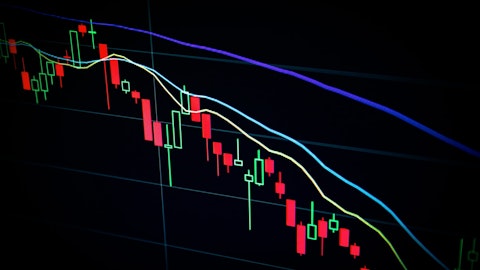But that comes at a cost, and that’s a chemo-like adverse event profile. And those are things like nausea, vomiting, stomatitis, alopecia, fatigue. These are things that you may see slight increases in efficacy, but clearly, patients don’t want that. And like — as Tom was mentioning with our platform and including Teliso-V, we have an opportunity there in the mutant side to combine with osimertinib, which has a nice profile. And those mutant patients when they progress, half of them have highly expressed c-Met. So that’s where a combo looks good. And then we’re also seeing 50% ORR in that segment as well. And we have a plan to get into Phase 3 into that next year. And then as we think about heme, we spoke about 383, which we feel has best-in-class potential.
And one of the things that we’re observing with that one is the high level of efficacy. [PRFs], we’re driving down past grade 3 and now driving down to get past grade 2. So that enables the potential where you may not need hospitalization. And what you see now with the BCMA dual engagers is not just hospitalization but a REMS. And what we would add to that is dose spacing potentially every other month. So that one is a very nice profile, and we’re moving into Phase 3 with that one, and we continue to conduct a variety of combinations there so we can move into earlier lines of therapy in multiple myeloma. We are still moving into earlier lines in Phase 3s with EPKINLY in heme, which is another dual engager. We have an asset called 453, which is our next-gen BCL2 blocker.
And then we have a BTK degrader called 101 that’s also in clinic. So quite a comprehensive approach across oncology.
Operator: Our next question comes from Geoff Meacham with Bank of America.
Geoff Meacham : Just have a couple of quick ones, one on immunology. So you guys have evaluated the impact from Humira biosimilars beyond even 25%, is it your view that tail revenues are likely to be better than you initially modeled. And what, if anything, do Stelara, the delay in Stelara biosimilars impact this. And the second question, just on capital deployment. Just given your higher guidance, I know you guys just raised the dividend, but would you also say that the deal capacity is higher. I know you recently raised kind of M&A range and wondering if that’s even going higher.
Jeff Stewart : Yes. Geoff, it’s Jeff here. And we continue to study the tail. I mean it’s something that we’re — we look very closely at — we continue to think that the Humira tail will emerge sometime in ’25 or ’26. And that’s looking at some of the international analogs, how we think we see pricing may move I mean the one thing that we do believe is that you’re not going to have a small molecule like tail, which is virtually nothing. There’s going to be a sub-segment of patients that are going to stay on Humira. It’s going to be modest, whether it’s low price or low volume, but it will be there even in an interchangeable world. We don’t necessarily believe that since we’ve outperformed here in volume in ’23 that that’s going to fundamentally change our view on the tail at this point.
And again, we’re still highlighting that. In terms of Stelara, obviously, we think in the U.S. that will not come until — and I think it was recently confirmed this week until sometime in ’25. And so overall, we think that’s a modest net positive for AbbVie in terms of how that may play out. But that’s not the primary driver of our strategy. Our primary driver of the strategy is how distinctive we are across our indications with Skyrizi versus Stelara, which I’ve already highlighted. So I hope that helps.
Rob Michael : And Jeff, this is Rob. You’re right. We did lift the cap. We had put that $2 billion BD cap in place, although we are rapidly paying down debt. And we lifted that at the beginning of this year because we essentially — by the end of this year, we’re going to have paid off all the incremental financing from the Allergan transaction. As Scott mentioned, our net leverage ratio is around 1.8x. And I have said previously that as long as we’re going to pass back to 2x that leverage in 2 to 3 years, that’s the way we’re thinking about balance sheet capacity. So as we look at it, there’s nothing from a balance capacity standpoint that would limit us today for pursuing the opportunities we’d be interested in. So that’s not a limiting factor.
And to the extent that we continue to raise guidance and perform more strongly. That just means there’s even more capacity. But there’s — at this point, that’s not a rate limiter for the types of opportunities we’d be interested in.
Operator: Our next question comes from Evan Seigerman with BMO Capital Markets.
Evan Seigerman : Congrats on a progress. I just wanted to touch on the dividend growth. So at first line, it seems that your dividend growth, while impressive, is slowing a bit relative to other recent periods. Maybe you could help us understand kind of what’s driving this dynamic at play? Is it concerns around near-term performance of key products you Humira erosion continuing next year? Or are you preserving capital for you to help further? Maybe some color on that would be very helpful.
Rob Michael : So Evan, it’s Rob. If you think about it, we’re delivering dividend growth both in ’23 and ’24, while earnings are not growing, right? So then you look at the payout ratio we’re at, we’re going to be in the mid-50s. And we have said that over the long term, if you look at just across the industry as well, I’d say a good target is in, say, the mid- to high 40% payout ratio, which would mean that during this period where you see our payout ratio go up in the future, we’re very committed to growing the dividend. We’ll continue to grow the dividend, but we would expect then earnings would grow faster than dividend increases. So I would say we’ve gone through this period for a couple of years where we are still delivering a very nice dividend growth despite earnings declining.





